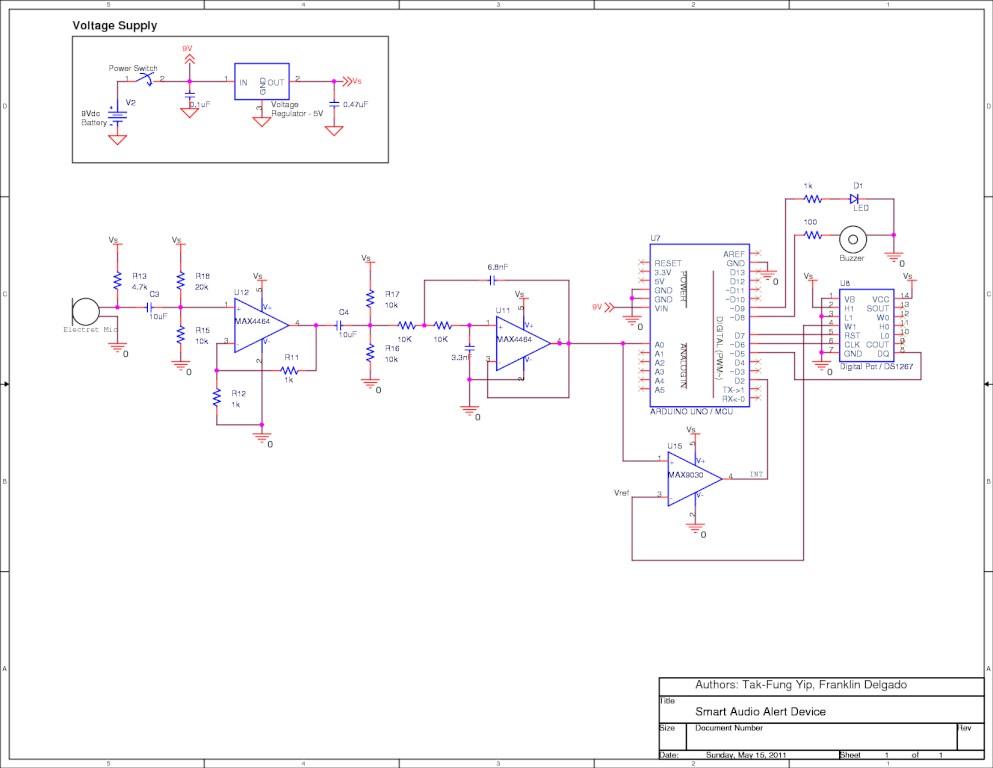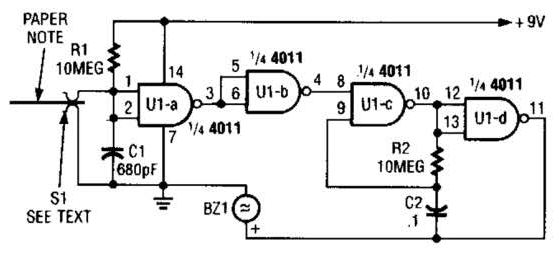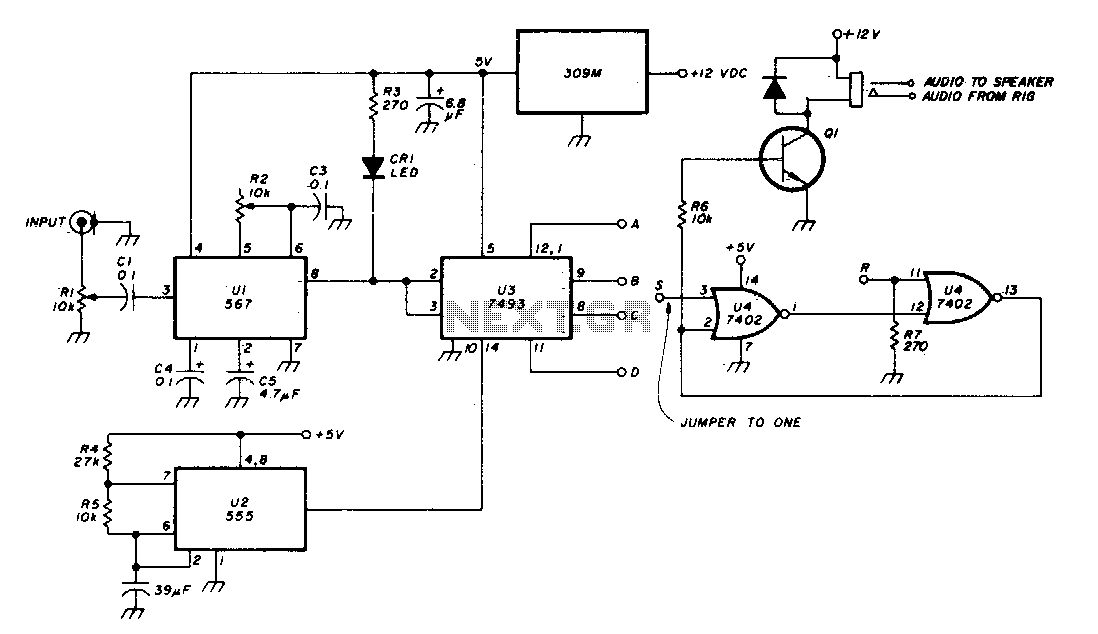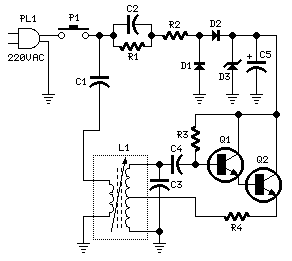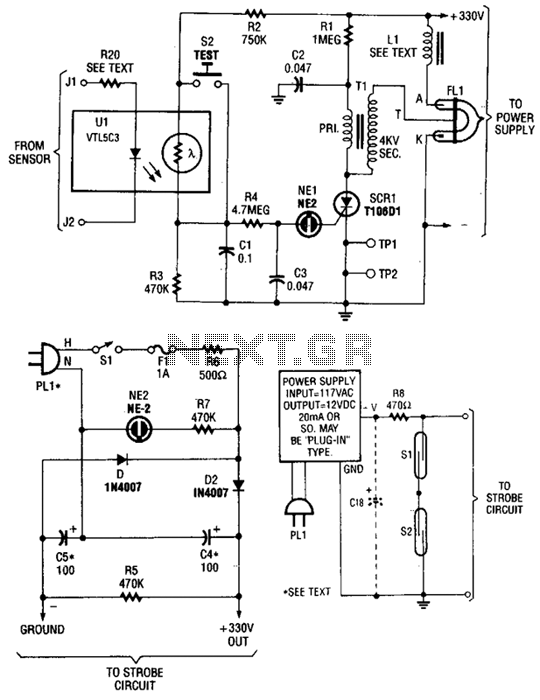
Speed-limit Alert
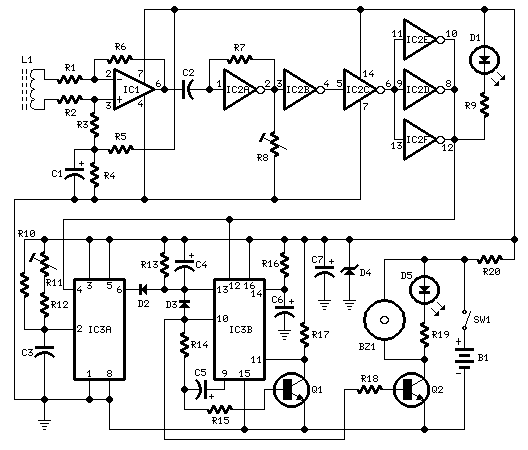
This circuit is designed to alert the vehicle driver when the maximum fixed speed limit is reached, such as on a motorway. It eliminates the need for the driver to look at the tachometer, reducing distraction while driving. The circuit monitors the relationship between the engine's RPM and the vehicle speed, activating an alert system that includes a beeping sound and a flashing LED once per second when the speed limit is exceeded. A key feature of this design is that it does not require a direct connection to the engine. The circuit utilizes IC1 as a differential amplifier for electromagnetic pulses generated by the engine's spark plugs, which are detected by the sensor coil L1. IC2A amplifies these pulses, while IC2B to IC2F function as inverters to provide clean pulse shaping. The monostable multivibrator IC3A acts as a frequency discriminator, with its pin 6 going high when the speed limit, set by resistor R11, is reached. IC3B, along with transistors and associated components, manages the timing for the signaling system, which includes LED D5 and piezo sounder BZ1. Diode D3 introduces a small amount of hysteresis into the circuit. Diode D1 is used during setup to monitor the emissions from the spark plugs, facilitating the optimal placement of the device on or near the dashboard. Once the setup is complete, D1 and resistor R9 can be removed or switched off to conserve battery power. During the initial operation, resistor R8 must be adjusted for optimal performance, typically between 10K and 20K. The final adjustment can be made with the assistance of another person: while driving, the helper should adjust trimmer R11 until the beeper and LED D5 activate at the desired speed, and the beeping should cease when the speed is reduced. The sensor coil L1 can be a 10mH inductor, often available in a small rectangular plastic housing. For increased sensitivity, a custom coil can be constructed by winding 130 to 150 turns of 0.2 mm enameled wire around a 5 cm diameter form, such as a can, and securing it with insulating tape. The circuit typically draws approximately 10mA of current. If connected to the vehicle's 12V battery, the device can be plugged into the lighter socket, requiring R20 to be set to 330 ohms. For testing, temporarily disconnect capacitor C2 from pin 6 of IC1, connect a signal generator's output to C2 and ground, set the generator to 100Hz, and adjust R11 until the beeping and LED D5 flashing is observed. Reducing the frequency to 99 or 98 Hz should stop the beeping and flashing.
This circuit operates based on the principle of monitoring engine RPM to provide a non-intrusive alert system for the driver. The differential amplifier formed by IC1 is crucial for capturing the electromagnetic pulses generated by the engine's spark plugs. The sensor coil L1 is strategically placed to ensure optimal sensitivity to these pulses. The amplified signals are then processed by a series of inverters (IC2B to IC2F), ensuring that the pulses are squared for reliable detection.
The monostable multivibrator IC3A plays a vital role in establishing a threshold for the speed limit detection. When the vehicle reaches the predetermined speed, the output at pin 6 goes high, triggering the alert system. The combination of the beeper and LED D5 provides both audible and visual feedback, enhancing the driver's awareness of speed limits.
The circuit's design allows for easy calibration through the use of trimmer resistors, which enable fine-tuning of the response to the vehicle's speed. The option to bypass certain components after calibration ensures that the circuit remains efficient and conserves battery power when not in use. The use of a compact inductor for the sensor coil allows for easy integration into the vehicle's dashboard or nearby areas, maintaining a clean and unobtrusive installation.
Overall, this speed alert circuit is an effective solution for enhancing driver safety by reducing distractions associated with monitoring speed through traditional instruments. It combines simplicity in design with effective functionality, making it suitable for a wide range of vehicles.This circuit has been designed to alert the vehicle driver that he has reached the maximum fixed speed limit (i. e. in a motorway). It eliminates the necessity of looking at the tachometer and to be distracted from driving. There is a strict relation between engine`s RPM and vehicle speed, so this device controls RPM, starting to beep and flashing
a LED once per second, when maximum fixed speed is reached. Its outstanding feature lies in the fact that no connection is required from circuit to engine. IC1 forms a differential amplifier for the electromagnetic pulses generated by the engine sparking-plugs, picked-up by sensor coil L1. IC2A further amplifies the pulses and IC2B to IC2F inverters provide clean pulse squaring. The monostable multivibrator IC3A is used as a frequency discriminator, its pin 6 going firmly high when speed limit (settled by R11) is reached.
IC3B, the transistors and associate components provide timings for the signaling part, formed by LED D5 and piezo sounder BZ1. D3 introduces a small amount of hysteresis. * D1 is necessary at set-up to monitor the sparking-plugs emission, thus permitting to find easily the best placement for the device on the dashboard or close to it.
After the setting is done, D1 & R9 can be omitted or switched-off, with battery saving. * During the preceding operation R8 must be adjusted for better results. The best setting of this trimmer is usually obtained when its value lies between 10 and 20K. * The final simplest setting can be made with the help of a second person. Drive the vehicle and reach the speed needed. The helper must adjust the trimmer R11 until the device operates the beeper and D5. Reducing car`s speed the beep must stop. * L1 can be a 10mH small inductor usually sold in the form of a tiny rectangular plastic box. If you need an higher sensitivity you can build a special coil, winding 130 to 150 turns of 0. 2 mm. enameled wire on a 5 cm. diameter former (e. g. a can). Extract the coil from the former and tape it with insulating tape making thus a stand-alone coil. * Circuit`s current drawing is approx. 10mA. If you intend to use the car`s 12V battery, you can connect the device to the lighter socket. In this case R20 must be 330R. * Temporarily disconnect C2 from IC1`s pin 6. Connect the generator`s output to C2 and Ground. Set the generator`s frequency to i. e. 100Hz and regulate R11 until you hear the beeps and LED D5 flashes. Reducing the frequency to 99 or 98 Hz, beeping and flashing must stop. 🔗 External reference
This circuit operates based on the principle of monitoring engine RPM to provide a non-intrusive alert system for the driver. The differential amplifier formed by IC1 is crucial for capturing the electromagnetic pulses generated by the engine's spark plugs. The sensor coil L1 is strategically placed to ensure optimal sensitivity to these pulses. The amplified signals are then processed by a series of inverters (IC2B to IC2F), ensuring that the pulses are squared for reliable detection.
The monostable multivibrator IC3A plays a vital role in establishing a threshold for the speed limit detection. When the vehicle reaches the predetermined speed, the output at pin 6 goes high, triggering the alert system. The combination of the beeper and LED D5 provides both audible and visual feedback, enhancing the driver's awareness of speed limits.
The circuit's design allows for easy calibration through the use of trimmer resistors, which enable fine-tuning of the response to the vehicle's speed. The option to bypass certain components after calibration ensures that the circuit remains efficient and conserves battery power when not in use. The use of a compact inductor for the sensor coil allows for easy integration into the vehicle's dashboard or nearby areas, maintaining a clean and unobtrusive installation.
Overall, this speed alert circuit is an effective solution for enhancing driver safety by reducing distractions associated with monitoring speed through traditional instruments. It combines simplicity in design with effective functionality, making it suitable for a wide range of vehicles.This circuit has been designed to alert the vehicle driver that he has reached the maximum fixed speed limit (i. e. in a motorway). It eliminates the necessity of looking at the tachometer and to be distracted from driving. There is a strict relation between engine`s RPM and vehicle speed, so this device controls RPM, starting to beep and flashing
a LED once per second, when maximum fixed speed is reached. Its outstanding feature lies in the fact that no connection is required from circuit to engine. IC1 forms a differential amplifier for the electromagnetic pulses generated by the engine sparking-plugs, picked-up by sensor coil L1. IC2A further amplifies the pulses and IC2B to IC2F inverters provide clean pulse squaring. The monostable multivibrator IC3A is used as a frequency discriminator, its pin 6 going firmly high when speed limit (settled by R11) is reached.
IC3B, the transistors and associate components provide timings for the signaling part, formed by LED D5 and piezo sounder BZ1. D3 introduces a small amount of hysteresis. * D1 is necessary at set-up to monitor the sparking-plugs emission, thus permitting to find easily the best placement for the device on the dashboard or close to it.
After the setting is done, D1 & R9 can be omitted or switched-off, with battery saving. * During the preceding operation R8 must be adjusted for better results. The best setting of this trimmer is usually obtained when its value lies between 10 and 20K. * The final simplest setting can be made with the help of a second person. Drive the vehicle and reach the speed needed. The helper must adjust the trimmer R11 until the device operates the beeper and D5. Reducing car`s speed the beep must stop. * L1 can be a 10mH small inductor usually sold in the form of a tiny rectangular plastic box. If you need an higher sensitivity you can build a special coil, winding 130 to 150 turns of 0. 2 mm. enameled wire on a 5 cm. diameter former (e. g. a can). Extract the coil from the former and tape it with insulating tape making thus a stand-alone coil. * Circuit`s current drawing is approx. 10mA. If you intend to use the car`s 12V battery, you can connect the device to the lighter socket. In this case R20 must be 330R. * Temporarily disconnect C2 from IC1`s pin 6. Connect the generator`s output to C2 and Ground. Set the generator`s frequency to i. e. 100Hz and regulate R11 until you hear the beeps and LED D5 flashes. Reducing the frequency to 99 or 98 Hz, beeping and flashing must stop. 🔗 External reference
